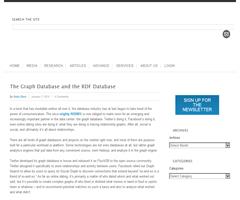Choosing Between Graph Databases and RDF Engines for Consuming and Mining Linked Data (Universidad Simon Bolívar, Caracas, Venezuela)

Comunidad pública de acceso restringido
Next Web: web 3.0, web semántica y el futuro de internet
Comunidad pública de acceso restringido
Solicita acceso a esta comunidad
Next Web es un espacio donde en estos más de 10 años se ha recopilado y analizado el desarrollo de la web y el modo en el que el conjunto de tecnologías emergentes que están haciendo posible internet están influyendo en el desarrollo de una vida socio-digital feliz, la construcción de la identidad digital de las personas y las organizaciones y la aceleración de los procesos sociales de aprendizaje. Todo ello gracias al ejercicio de la sociabilidad simultánea y al acceso a la información e inteligencia ubicuas.
Empresas, agentes de capital riesgo, instituciones, investigadores, profesores, ‘start-ups’, ‘bloggers’, internautas avanzados, activistas en internet y, en general, todos aquellos que crean en el poder de transformación social de la tecnología, tienen su espacio en Next Web, comunidad promovida por el Equipo GNOSS.
29/10/2015

Graph Databases vs. RDF Triple Stores
To summarize, both graph databases and triple stores are designed to store linked data. RDF is a specific kind of linked data that is queried using SPARQL, so it is fair to say that RDF triple stores are a kind of graph database. But, there are some subtle but important differences that are described below.
How They Are Similar
· Graph databases and rdf triple stores focus on the relationships between the data, often referred to as “linked data.” Data points are called nodes, and the relationship between one data point and another is called an edge.
· A web of nodes and edges can be put together into interesting visualizations—a defining characteristic of graph databases.
How They Are Different
· Graph databases are more versatile with query languages: Neo4J can run an RDF triple store and use SPARQL but generally focuses on its own proprietary language, Cypher. Other graph databases support G, GraphLog, GOOD, SoSQL, BiQL, SNQL, and more. RDF triple stores only use SPARQL as the query language.
· Graph databases can store various types of graphs, including undirected graphs, weighted graphs, hypergraphs, etc. RDF triple stores focus solely on storing rows of RDF triples.
· Graph databases are node, or property, centric whereas RDF triple stores are edge-centric. RDF triple stores are really just a list of graph edges, many of which are 'properties' of a node and not critical to the graph structure itself.
· Graph databases are better optimized for graph traversals (degrees of separation or shortest path algorithms). With RDF triple stores, the cost of traversing an edge tends to be logarithmic.
· RDF triple stores also provide inferences on data but graph databases do not (e.g., if humans are a subclass of mammals and man is a subclass of humans, then it can be inferred that man is a subclass of mammals).
· RDF triple stores are more synonymous with the “semantic web” and the standardized universe of knowledge being stored as RDF triples on DBpedia and other sources whereas graph databases are seen as more pragmatic rather than academic.
Autores:
Categorías:
Etiquetas:
Licencia:


